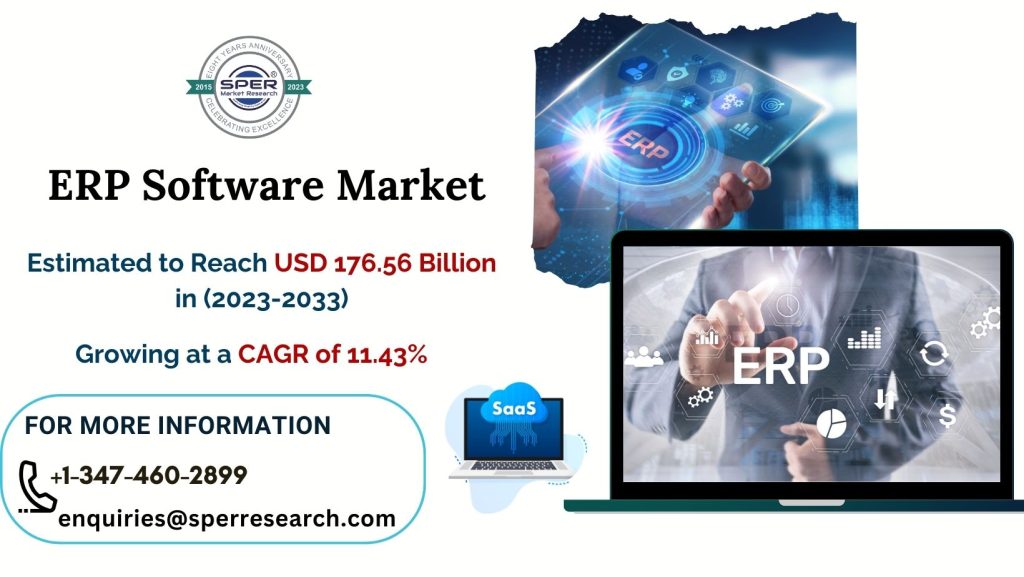Enterprise Resource Planning Software Market Share, Revenue, Emerging Trends, Growth Drivers, Challenges, Opportunities and Forecast Till 2033: SPER Market Research

Enterprise Resource Planning (ERP) software is a collection of integrated programmes that help manage fundamental business activities such as finance, human resources, supply chain, manufacturing, customer relationship management (CRM), and more. It offers a unified platform for data storage, analysis, and collaboration, allowing companies to streamline operations and make data-driven decisions. ERP software removes the need for many systems and manual processes, resulting in higher productivity and cost savings.
According to SPER market research, ‘ERP Software Market Size- By Function, By Size, By Deployment, By End User- Regional Outlook, Competitive Strategies and Segment Forecast to 2033’ state that the Global ERP Software Market is predicted to reach USD 176.56 billion by 2033 with a CAGR of 11.43%.
The growing need for operational efficiency and transparency in company operations, the rise in demand for data-driven choices, and the use of mobile and cloud applications are all driving the ERP software market forward. However, the increasing availability of open-source applications, as well as higher initial investment and maintenance expenses, are expected to slow market development. A growth in demand for cloud-based ERP solutions, particularly from small and medium-sized organisations, is expected to open up new opportunities for market players.
Request For Free Sample Report @ https://www.sperresearch.com/report-store/erp-software-market.aspx?sample=1
The low infrastructure costs and software’s ability to interface with mobile devices are expected to grow the market for cloud services. Mobile is an essential component of the workplace culture, and businesses are willing to spend money on cloud-connected mobile applications. It allows individual users to synchronise, update, and control documents. The popularity of cloud and mobile apps is increasing, which is helping the ERP industry grow.
Furthermore, when business applications increase and data is generated across various supply chains, firms can implement a centralised platform that manages all processes. As a result of increasing automation and technological deployments in the supply chain management process, demand for ERP systems has surged, leading to market growth.
CHALLENGES/RESTRAINTS:
- High implementation and maintenance costs: Implementing an ERP system may be a considerable financial expenditure for organisations, particularly small and medium-sized firms. Additionally, continuing maintenance and upgrade expenditures might raise the total cost of ownership, making it difficult for some organisations.
- ERP implementations frequently include complicated processes that require customisation to meet the specific needs of an organisation. Managing the customisation process can be difficult and may result in delays and increased expenditures.
COVID Impact: The COVID-19 pandemic resulted in widespread lockdowns and the closure of non-essential firms, lowering demand for cloud-based ERPs as corporations focused on cost-cutting and profitability. Furthermore, firms prioritised developing their core skills and cutting costs by eliminating some offices. However, as many nations’ lockdown measures are gradually lifted and governments enable enterprises to operate under safety standards, demand for cloud ERPs is projected to rise in the coming months. Furthermore, continued technological breakthroughs and innovations are expected to fuel long-term demand for cloud ERP systems.
North America dominated the ERP software market. This dominance is due to growing use by small and medium-sized businesses, greater investments by ERP suppliers in new technology, and the presence of a large number of market participants. The Asia-Pacific area is primed for growth as a result of a robust manufacturing sector, expanding SMEs, and rising demand for cloud-based solutions, which is being driven by government IT infrastructure investments.
Additionally, some of the market key players are Acumatica, Oracle Corporation, Plex System, QAD Inc., Ramco System, Sage Group, plc, SAP SE, SYSPRO, TOTVS S.A., Workday, Inc., Others.
Global Enterprise Resource Planning Software Market Segmentation:
By Function: Based on the Function, Global ERP Software Market is segmented as; Customer Management, Finance, Human Resource, Inventory Management, Supply Chain Management, Others.
By Size: Based on the Size, Global ERP Software Market is segmented as; Large Enterprises, Medium Enterprises, Small Enterprises.
By Deployment: Based on the Deployment, Global ERP Software Market is segmented as; Cloud, Hybrid, On-Premises.
By End User: Based on the End User, Global ERP Software Market is segmented as; Aero-Space & Defense, Banking, Financial Services, and Insurance (BFSI), Construction, Government & Utilities, Healthcare & Life Sciences, IT & Telecom, Manufacturing, Transportation & Logistics, Others.
By Region: This report also provides the data for key regional segments of Asia Pacific, Europe, Middle East and Africa, North America, Latin America.
This study also encompasses various drivers and restraining factors of this market for the forecast period. Various growth opportunities are also discussed in the report.
For More Information, refer to below link:-
Related Reports:
Follow Us –
LinkedIn | Instagram | Facebook | Twitter
Contact Us:
Sara Lopes, Business Consultant – U.S.A.
SPER Market Research
+1-347-460-2899





